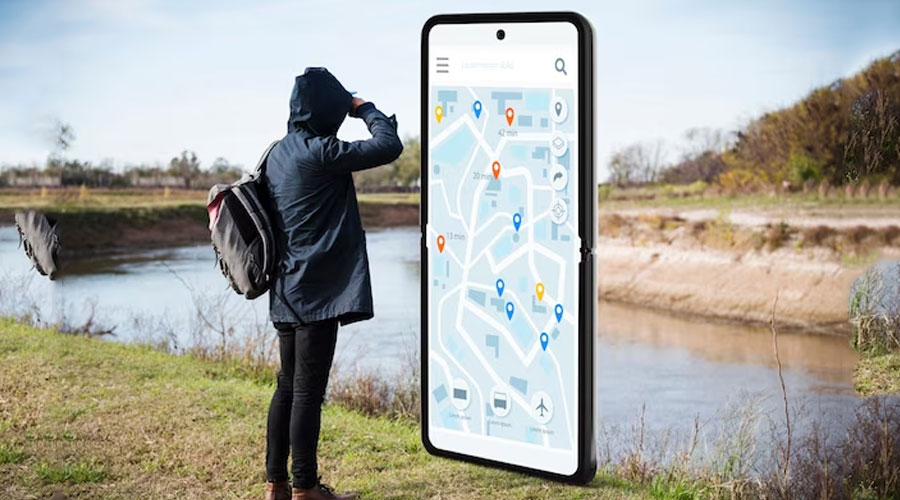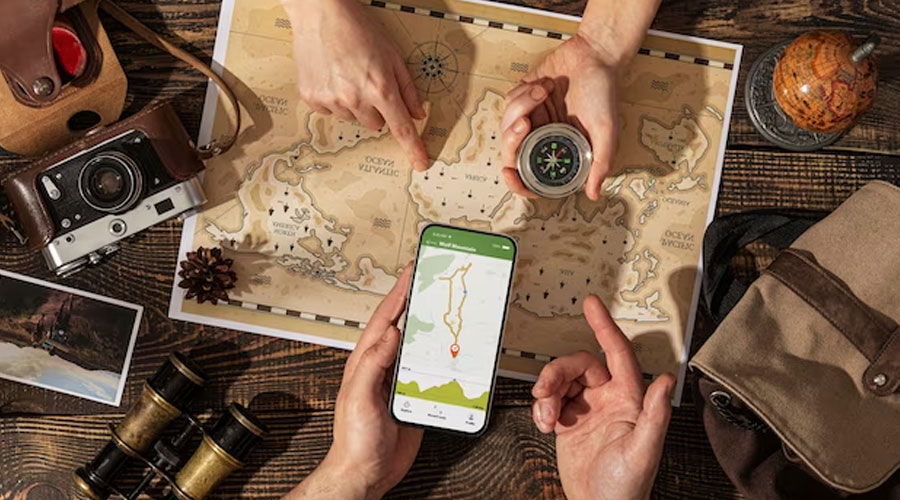Table of Contents
Introduction
In a world where digital technology has woven its way into every facet of our lives, it comes as no surprise that the realm of outdoor adventure and hiking has also undergone a digital revolution. Hiking and outdoor adventure app services have emerged as the compass, map, and trail guide for modern explorers. These apps, accessible through smartphones and other portable devices, have become an indispensable part of any adventurer’s toolkit, providing a multitude of features and functionalities that make outdoor escapades more accessible, enjoyable, and safe.
In this article, we embark on a journey through the fascinating landscape of hiking and outdoor adventure apps. We will explore how these applications have transformed the way we connect with nature, plan our outdoor expeditions, navigate the wilderness, and interact with fellow adventurers. From detailed trail maps and weather forecasting to safety features and vibrant online communities, these apps are opening up new horizons for outdoor enthusiasts of all levels of experience.
So, whether you’re a seasoned hiker looking to discover new trails or a beginner seeking guidance on your first outdoor adventure, these hiking and outdoor adventure apps are your trusted companions. Join us as we delve deeper into the benefits and functionalities of these apps, discover popular ones that have gained widespread recognition, and peer into the exciting future of outdoor exploration in the digital age.
Features of Top Hiking and Outdoor Adventure Apps
Building upon the discussion of popular hiking and outdoor adventure apps, let’s explore some of the additional features and functionalities that make these apps stand out in the market. These add-on features contribute to a more immersive, safe, and enjoyable outdoor experience:
- Custom Trail Creation: Many top hiking apps allow users to create and share their own custom trails. This feature is ideal for experienced hikers who want to share their unique routes or for those looking to explore off-the-beaten-path destinations.
- Offline Maps: The ability to download maps for offline use is essential, especially in remote areas with limited or no cellular service. Users can pre-download maps and access them without an internet connection, ensuring navigation remains reliable.
- Elevation Profiles: Hikers and backpackers often need to know the elevation changes along a trail. Elevation profiles provide crucial information for planning, as users can anticipate steep climbs and descents.
- Photo Integration: Many apps allow users to take and geotag photos during their adventures, creating an interactive visual journal of their outdoor experiences. These photos can be shared with the app’s community or on social media.
- Real-time Tracking: Some apps offer live tracking features, enabling friends and family to follow a user’s progress in real-time. This feature is valuable for safety and peace of mind, especially on long or challenging hikes.
- Fitness Tracking: Beyond navigation, some hiking apps incorporate fitness tracking features. Users can monitor their distance covered, elevation gain, and even track their heart rate, providing a holistic view of their outdoor activity.
- Wildlife Identification: As an educational component, certain apps offer wildlife identification guides. Users can snap photos of flora and fauna and receive information about what they’ve encountered.
- Geo-tagged Points of Interest: Discover interesting landmarks, historical sites, or natural attractions along your chosen route. These points of interest are often geotagged and include descriptions, enhancing the cultural and educational aspect of hiking.
- Advanced Route Planning: Some apps take route planning to the next level by considering factors like terrain difficulty, estimated time, and the best time to hike based on current weather conditions.
- Compatibility with Wearables: Hiking and outdoor adventure apps can often sync with popular smartwatches and wearables, providing a convenient way to access essential information on your wrist, such as navigation cues and heart rate data.
- Trail Sharing and Community Challenges: In-app challenges and community-driven events encourage users to push their limits and interact with like-minded adventurers. Completing challenges and sharing accomplishments can be highly motivating.
- First Aid Information: Safety is paramount in the great outdoors. Some apps include first aid guides, tips, and emergency contact information, ensuring users are prepared for unexpected situations.
- Trip Statistics and History: Users can view their trip history, including past hikes and detailed statistics, providing a sense of accomplishment and a record of their outdoor experiences.
- Social Sharing and Integration: Share your hikes and achievements on social media platforms directly from the app, allowing friends and followers to see your adventures and perhaps join in on the fun.
- Weather Radar and Alerts: In addition to weather forecasting, some apps integrate real-time weather radar and provide weather alerts. This feature is especially valuable for tracking sudden weather changes during a hike.
- Multilingual Support: For those traveling internationally or in diverse language regions, apps with multilingual support can be indispensable for seamless communication and navigation.
- Safety Beacon: In critical situations, a safety beacon feature can send out distress signals to designated contacts, ensuring quick assistance in emergencies.
- Leave No Trace Guidelines: Education on responsible outdoor ethics, such as Leave No Trace principles, can help users minimize their environmental impact and preserve the wilderness for future generations.
- Map Overlays and Layers: Customize the map display with overlays and layers, such as topographic maps, satellite imagery, or heatmaps showcasing popular trails.
- Historical Data and Insights: Some apps compile historical data, providing insights into the best times to visit certain areas, the most popular trails, and changes in trail conditions over time.
These additional features make hiking and outdoor adventure apps invaluable tools for outdoor enthusiasts. Whether you’re a solo hiker, a family looking for a fun day outdoors, or a group of friends embarking on a challenging expedition, these apps enhance your experience and ensure you make the most of your time in the great outdoors.
Trip Planning and Itinerary Management
While we’ve already discussed the numerous advantages of hiking and outdoor adventure apps, it’s essential to dive deeper into one of their most critical features – trip planning and itinerary management. This component of these apps takes the outdoor experience to the next level by helping users meticulously plan their adventures, ensuring a safe and enjoyable journey. In this section, we’ll explore how trip planning and itinerary management features are transforming the way outdoor enthusiasts prepare for their excursions.
-
Seamless Trip Planning
Trip planning is often the first step in preparing for an outdoor adventure. Hiking and outdoor adventure apps streamline this process, making it more accessible and efficient. Here’s how:
- Interactive Mapping: Many apps offer interactive maps that allow users to visualize potential routes and trail options. This feature simplifies the selection of a trail that matches your skill level, preferences, and time constraints.
- Trail Descriptions: Detailed trail descriptions, ratings, and user reviews help adventurers understand what to expect on a particular hike. This information ensures that your chosen trail aligns with your expectations.
- Estimated Duration: Apps often provide estimated hiking durations, enabling users to plan their day effectively. This information is invaluable for time management, especially when combining multiple trails or activities.
- Elevation Profiles: Elevation profiles assist in gauging the difficulty of a trail. By examining the ups and downs, hikers can be better prepared and ensure they have the right gear and physical fitness.
-
Customized Itinerary Management
Once the trip is planned, the next challenge is managing the itinerary. Hiking and outdoor adventure apps excel in this area by offering tools and features that help users stay organized:
- Itinerary Creation: Users can create detailed itineraries for their trips, including starting times, breaks, and endpoints. This level of planning ensures that no essential aspect of the adventure is overlooked.
- Real-time Updates: Some apps provide real-time updates on trail conditions, such as closures or weather changes. This allows users to adapt their itineraries on the fly for safety and comfort.
- Checklists and Reminders: Hiking apps often include features for creating checklists of essential gear and supplies. Additionally, they can set reminders for hikers to ensure nothing is left behind.
- Shareable Itineraries: Itinerary sharing is particularly valuable for group trips. Users can send their planned routes and schedules to friends and family, enhancing safety and ensuring that everyone is on the same page.
-
Advanced Features for the Adventurous
For those who love to push their outdoor limits, advanced features can be found in some hiking and outdoor adventure apps:
- Multi-day Trip Planning: Apps like Komoot are designed for those who embark on multi-day adventures. These apps allow users to plan complex routes and itineraries, including accommodations and rest stops.
- Offline Accessibility: Offline map access is crucial for remote areas without a stable internet connection. Many apps allow users to download maps for offline use during their adventures.
- GPX File Support: Some apps enable users to import and follow GPX files from other sources, further expanding the versatility of the platform.
- Virtual Exploration: VR integration might soon become a reality in hiking apps, allowing users to explore trails virtually before committing to a journey.
-
User Stories and Real-world Examples
The beauty of trip planning and itinerary management features in these apps lies in the real-world stories and examples of outdoor enthusiasts who have benefited from them:
- Climbing a Mountain: Imagine planning to climb a mountain and having a detailed itinerary with weather updates and trail conditions at your fingertips. This feature ensures you’re prepared for any unforeseen circumstances.
- Cross-country Bike Trip: For cyclists embarking on a cross-country adventure, apps like Komoot allow them to create a multi-day itinerary, plan for camping spots, and share their plans with fellow riders.
- Family Hiking Day: Families can utilize trip planning to ensure a seamless outdoor day. With itineraries that include restroom breaks and picnic spots, these apps make it easier for parents to keep kids comfortable and engaged.
Tips for Using Hiking and Outdoor Adventure Apps
let’s explore some valuable tips for making the most of hiking and outdoor adventure apps. These tips will help you navigate the wilderness more efficiently and enjoy a safer and more enjoyable outdoor experience:
- Download Maps for Offline Use:
- Before setting out on your adventure, download trail maps and relevant information for offline use. This ensures you can access maps and crucial data even in areas with poor or no cellular signal.
- Plan and Share Your Itinerary:
- Always share your hiking plans with a trusted friend or family member. Most hiking apps have a feature for sharing your itinerary, allowing someone to know your expected return time and location.
- Learn How to Use the App Before Heading Out:
- Familiarize yourself with the app’s features, especially if you’re using it for the first time. Understand how to set waypoints, track your route, and use any emergency features.
- Carry Backup Power:
- Using GPS and mapping features can drain your phone’s battery quickly. Carry a portable charger or a solar charger to ensure your phone remains charged throughout your hike.
- Use Airplane Mode to Conserve Battery:
- When you’re not actively using your phone for navigation or communication, switch it to airplane mode to conserve battery. This allows your device to focus on GPS tracking without the additional power drain from cellular and Wi-Fi connections.
- Check for App Updates:
- Regularly update your hiking app to ensure it has the latest maps and features. Outdated information could lead to navigation errors.
- Pack Paper Maps and a Compass:
- While hiking apps are incredibly useful, they shouldn’t be your sole navigation tool. Always carry paper maps of the area and a compass as a backup in case of technical failures.
- Practice Leave No Trace Principles:
- Follow Leave No Trace principles, which include packing out all trash, staying on designated trails, and respecting wildlife. Many hiking apps provide information on Leave No Trace practices.
- Understand Your App’s Tracking Capabilities:
- Different apps may offer varying levels of tracking accuracy. Some may use more battery for precise tracking, while others may provide general guidance. Understand the limitations of your app and how it tracks your location.
- Stay Informed About Weather Conditions:
- Regularly check weather updates on your app and be prepared for sudden weather changes. If conditions deteriorate, have a plan for a safe retreat.
- Respect Local Regulations:
- Be aware of and follow any local regulations, such as permit requirements or restricted areas. Many hiking apps provide information on trail regulations and guidelines.
- Document Your Adventures:
- Use the app’s features to record your hikes, take photos, and leave reviews. This not only helps you remember your experiences but also contributes to the outdoor community.
- Join Online Hiking Communities:
- Many hiking apps have associated online communities or forums where you can connect with fellow hikers, share experiences, and gain insights into new trails and outdoor tips.
- Practice Safety and First Aid:
- Carry a basic first aid kit, familiarize yourself with how to use it, and know basic first aid principles. Your app may also have emergency information and resources.
- Stay Hydrated and Informed:
- Use the app to plan water stops along your route, and stay well-hydrated. Additionally, use the app to keep track of the latest news, alerts, and trail conditions that might affect your hike.
User Stories and Experiences
User Story 1: Sarah’s First Solo Hike
Sarah, a young outdoor enthusiast, had always dreamt of conquering the trails on her own. Nervous but determined, she downloaded the AllTrails app for her first solo hiking adventure. Using the app’s user-friendly interface, she discovered a local trail that matched her skill level and preferences. The detailed trail map, reviews, and safety information provided her with the confidence she needed. Sarah shared her journey in the app’s community forum, receiving tips and encouragement from fellow hikers, making her feel less alone during her solo adventure.
User Story 2: Mark’s Gaia GPS Adventure
Mark, an experienced backpacker, recently embarked on an ambitious backcountry journey. He relied on the Gaia GPS app for this rugged adventure. Gaia GPS’s topographic maps, route planning, and offline capabilities were indispensable, given the remote areas he was exploring. During his journey, he encountered unexpected weather changes. Gaia GPS’s real-time weather updates allowed Mark to adjust his route, ensuring a safer and more enjoyable experience. He shared his trail experience and route details with friends, inspiring them to embark on their adventures.
User Story 3: Emily’s Discoveries with Hiking Project
Emily, an avid hiker, frequently uses the Hiking Project app to explore new trails. She found this app particularly useful during her family vacation in the mountains. Hiking Project’s extensive trail descriptions and offline maps helped her select family-friendly routes. During her hikes, she appreciated the app’s navigation assistance, as it kept her and her family on the right track. Emily later uploaded her photos and reviews of the trails she explored, contributing to the Hiking Project community and helping other families plan their outdoor adventures.
User Story 4: Jake’s Mountain Biking Adventure with Komoot
Jake, a mountain biking enthusiast, embarked on a multi-day adventure using the Komoot app. The app’s turn-by-turn voice navigation was instrumental in guiding him through rugged terrain. He planned his trip in advance, creating a detailed route that showcased the most exhilarating trails and scenic spots. Komoot’s offline maps ensured he never lost his way, even in areas with poor cellular coverage. Jake documented his adventure, including stunning photos and insightful tips, sharing them with the Komoot community of fellow mountain bikers.
User Story 5: Maria’s European Exploration with Outdooractive
Maria, a nature lover, planned a backpacking adventure across Europe. She relied on the Outdooractive app to find hiking, cycling, and skiing trails. This app allowed her to seamlessly switch between different activities based on her location and preferences. Maria utilized the app’s trail descriptions, event calendar, and route planning to create a customized itinerary for her trip. Throughout her journey, she used Outdooractive to stay updated on local conservation initiatives, deepening her appreciation for the natural world and the importance of responsible outdoor exploration.
These user stories and experiences highlight how hiking and outdoor adventure app services are not only functional but also deeply enriching for users. They provide a sense of community, enhance safety, and facilitate personal connections with nature. As these apps continue to evolve, they will undoubtedly inspire more stories of outdoor exploration and adventure.
Future Trends in Outdoor Adventure App Development
The world of outdoor adventure app development is continually evolving, driven by technological advancements and the growing demand for more innovative and user-friendly solutions. In this section, we’ll explore some of the exciting future trends in outdoor adventure app development that are likely to shape the way we interact with nature and experience the great outdoors.
- Artificial Intelligence and Machine Learning: The integration of artificial intelligence (AI) and machine learning (ML) is poised to revolutionize outdoor adventure apps. These technologies can analyze user preferences and behaviors, providing personalized recommendations for hiking trails, camping spots, and outdoor activities. AI and ML can also be used to enhance navigation and provide real-time alerts for weather changes or potential hazards. Additionally, they can assist in optimizing packing lists and gear recommendations based on the user’s specific adventure.
- Blockchain for Safety and Conservation: Blockchain technology can be leveraged for safety and conservation efforts in outdoor adventure apps. By using blockchain to verify and share real-time safety data, such as trail conditions and weather updates, hikers can make more informed decisions. This technology can also support conservation initiatives by allowing users to participate in micro-donations for environmental protection and wildlife preservation.
- Virtual Reality (VR) and Augmented Reality (AR): The incorporation of VR and AR into outdoor adventure apps can offer users immersive experiences. For instance, hikers can don VR headsets to explore trails virtually before embarking on a physical adventure. AR, on the other hand, can overlay real-time information about the surroundings, including identifying flora and fauna, historical landmarks, and trail difficulty levels.
- Community Collaboration and Crowdsourced Data: The future of outdoor adventure apps lies in enhanced community collaboration. Users can actively contribute to the app’s content by sharing their experiences, trails, and information about local conditions. This crowdsourced data can provide real-time insights into trail conditions, wildlife sightings, and even hidden gems that are off the beaten path.
- Sustainability and Eco-Friendly Features: With a growing emphasis on environmental sustainability, outdoor adventure apps are likely to incorporate eco-friendly features. These might include carbon footprint tracking for outdoor trips, recommendations for eco-friendly gear and products, and information on sustainable practices while hiking and camping.
- Offline-First Capabilities: Many outdoor adventures take place in remote areas with limited or no internet connectivity. Future apps will prioritize offline-first capabilities, allowing users to download maps, trail information, and safety data for reference when they are off the grid. This ensures that hikers and campers can still access vital information in remote locations.
- Wearable Integration: The integration of outdoor adventure apps with wearable devices like smartwatches and fitness trackers will become more seamless. This will provide users with real-time information on their wrist, such as heart rate, distance covered, and elevation gain, enhancing safety and performance during outdoor activities.
- Environmental Sensing and Monitoring: Apps may feature built-in environmental sensors that monitor air quality, temperature, and other environmental factors. This data can be used to provide users with health and safety recommendations, especially in areas prone to rapidly changing conditions.
- Offline Community Building: Even in remote locations, users will be able to engage with the app’s community features. This might include the ability to leave virtual trail markers, messages, or digital tokens for fellow adventurers, fostering a sense of community and connection even in the most isolated places.
- Multi-Activity Integration: Future apps will cater to a wide range of outdoor activities, including hiking, biking, climbing, skiing, and water sports. Users will have the convenience of a single app that can assist them in planning and executing various outdoor adventures.
























